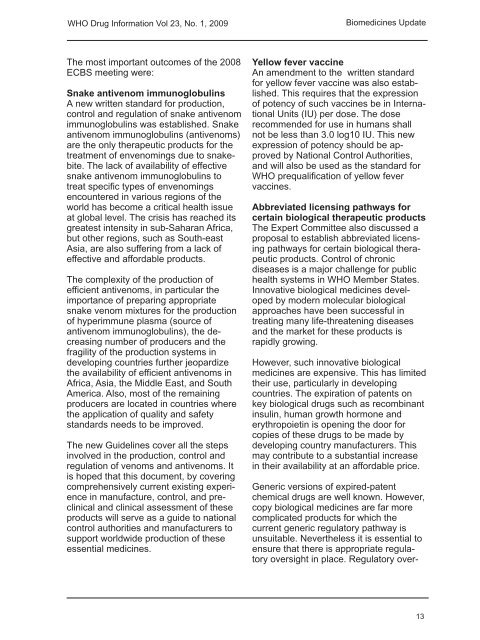WHO Drug Information Vol. 23, No. 1, 2009 - World Health ...
WHO Drug Information Vol. 23, No. 1, 2009 - World Health ...
WHO Drug Information Vol. 23, No. 1, 2009 - World Health ...
Create successful ePaper yourself
Turn your PDF publications into a flip-book with our unique Google optimized e-Paper software.
<strong>WHO</strong> <strong>Drug</strong> <strong>Information</strong> <strong>Vol</strong> <strong>23</strong>, <strong>No</strong>. 1, <strong>2009</strong>Biomedicines UpdateThe most important outcomes of the 2008ECBS meeting were:Snake antivenom immunoglobulinsA new written standard for production,control and regulation of snake antivenomimmunoglobulins was established. Snakeantivenom immunoglobulins (antivenoms)are the only therapeutic products for thetreatment of envenomings due to snakebite.The lack of availability of effectivesnake antivenom immunoglobulins totreat specific types of envenomingsencountered in various regions of theworld has become a critical health issueat global level. The crisis has reached itsgreatest intensity in sub-Saharan Africa,but other regions, such as South-eastAsia, are also suffering from a lack ofeffective and affordable products.The complexity of the production ofefficient antivenoms, in particular theimportance of preparing appropriatesnake venom mixtures for the productionof hyperimmune plasma (source ofantivenom immunoglobulins), the decreasingnumber of producers and thefragility of the production systems indeveloping countries further jeopardizethe availability of efficient antivenoms inAfrica, Asia, the Middle East, and SouthAmerica. Also, most of the remainingproducers are located in countries wherethe application of quality and safetystandards needs to be improved.The new Guidelines cover all the stepsinvolved in the production, control andregulation of venoms and antivenoms. Itis hoped that this document, by coveringcomprehensively current existing experiencein manufacture, control, and preclinicaland clinical assessment of theseproducts will serve as a guide to nationalcontrol authorities and manufacturers tosupport worldwide production of theseessential medicines.Yellow fever vaccineAn amendment to the written standardfor yellow fever vaccine was also established.This requires that the expressionof potency of such vaccines be in InternationalUnits (IU) per dose. The doserecommended for use in humans shallnot be less than 3.0 log10 IU. This newexpression of potency should be approvedby National Control Authorities,and will also be used as the standard for<strong>WHO</strong> prequalification of yellow fevervaccines.Abbreviated licensing pathways forcertain biological therapeutic productsThe Expert Committee also discussed aproposal to establish abbreviated licensingpathways for certain biological therapeuticproducts. Control of chronicdiseases is a major challenge for publichealth systems in <strong>WHO</strong> Member States.Innovative biological medicines developedby modern molecular biologicalapproaches have been successful intreating many life-threatening diseasesand the market for these products israpidly growing.However, such innovative biologicalmedicines are expensive. This has limitedtheir use, particularly in developingcountries. The expiration of patents onkey biological drugs such as recombinantinsulin, human growth hormone anderythropoietin is opening the door forcopies of these drugs to be made bydeveloping country manufacturers. Thismay contribute to a substantial increasein their availability at an affordable price.Generic versions of expired-patentchemical drugs are well known. However,copy biological medicines are far morecomplicated products for which thecurrent generic regulatory pathway isunsuitable. Nevertheless it is essential toensure that there is appropriate regulatoryoversight in place. Regulatory over-13

















